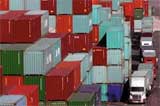The nightmare that has been the ports of Los Angeles and Long Beach for about a year in term of container ships waiting many days for a berth to unload is almost over – only to see the bottleneck move to the rail yards.
Supply Chain Digest Says... |
 |
|
Unions say a key problem is that railroads laid off about 45,000 workers during the pandemic stating in 2020. |
|
 |
|
What do you say? |
|
| Click here to send us your comments |
|
| |
|
| Click here to see reader feedback |
|
|
|
At its peak in January of this year, there were a total of 109 ships waiting at sea outside the twin ports. Last week, that number had fallen to just nine vessels – a decrease of some 90%.
One key new weapon in the ports' arsenal for generating a smooth flow of goods: are high tech digital data trackers that give the ports visibility to key information on the ships headed to one of the two ports, container volumes, and expected arrival times.
“I feel really good about where we are compared to last October,” Port of LA Executive Director Gene Seroka told Transport Topics magazine. Seroka also noted that while he expected big improvements from the digital tracking system, the result has exceed his expectations, and that he was surprised by the level of detail in the data.
The ports need all help they can get, with container volumes still soaring. For example, the Port of Long Beach handled 785,843 20-foot-equivalent units in July, setting a record with a slight increase of the number from July of 2021.
But now signs the bottleneck is moving from the ports to the rail yards that serve them.
Growing back-ups at rail carriers have increased the ports’ terminal dwell times. The rail carriers, port officials say, are hampered by a lack of both equipment and rail workers, which the train companies have also acknowledged.
“It does affect” the supply chain, the Port of LA’s Seroka told Transport Topics relative to the rail situation, “but it’s not putting us in dire straits and we’re not in gridlock.”
(See More Below)
|
CATEGORY SPONSOR: SOFTEON |
|
|
|
|
|
 Unions say a key problem is that railroads laid off about 45,000 workers during the pandemic stating in 2020. The result, they say: many of those workers never returned, and the training of new employees has taken longer than expected. Unions say a key problem is that railroads laid off about 45,000 workers during the pandemic stating in 2020. The result, they say: many of those workers never returned, and the training of new employees has taken longer than expected.
Equipment shortages are also a factor.
“The railroads cannot even provide us with a schedule of arriving trains into the port,” said Ramon Ponce De Leon, coast committeeman for the longshoremen’s union, at a recent at a virtual US Freight and Railroad Worker Town Hall meeting on Aug. 12. “There are longer wait times being passed on to consumers and we’ve had a record number of cargo sitting on the docks.”
Major rail hubs near cities such Dallas, Chicago, Atlanta, San Antonio, and Houston are themselves backed up, preventing containers from being picked up at the ports.
“Importers are not picking up their cargo fast enough,” Seroka said.
What are your thoughts on what's happening at LA/Long Beach? Let us know your thoughts at the Feedback section below.
Your Comments/Feedback
|

